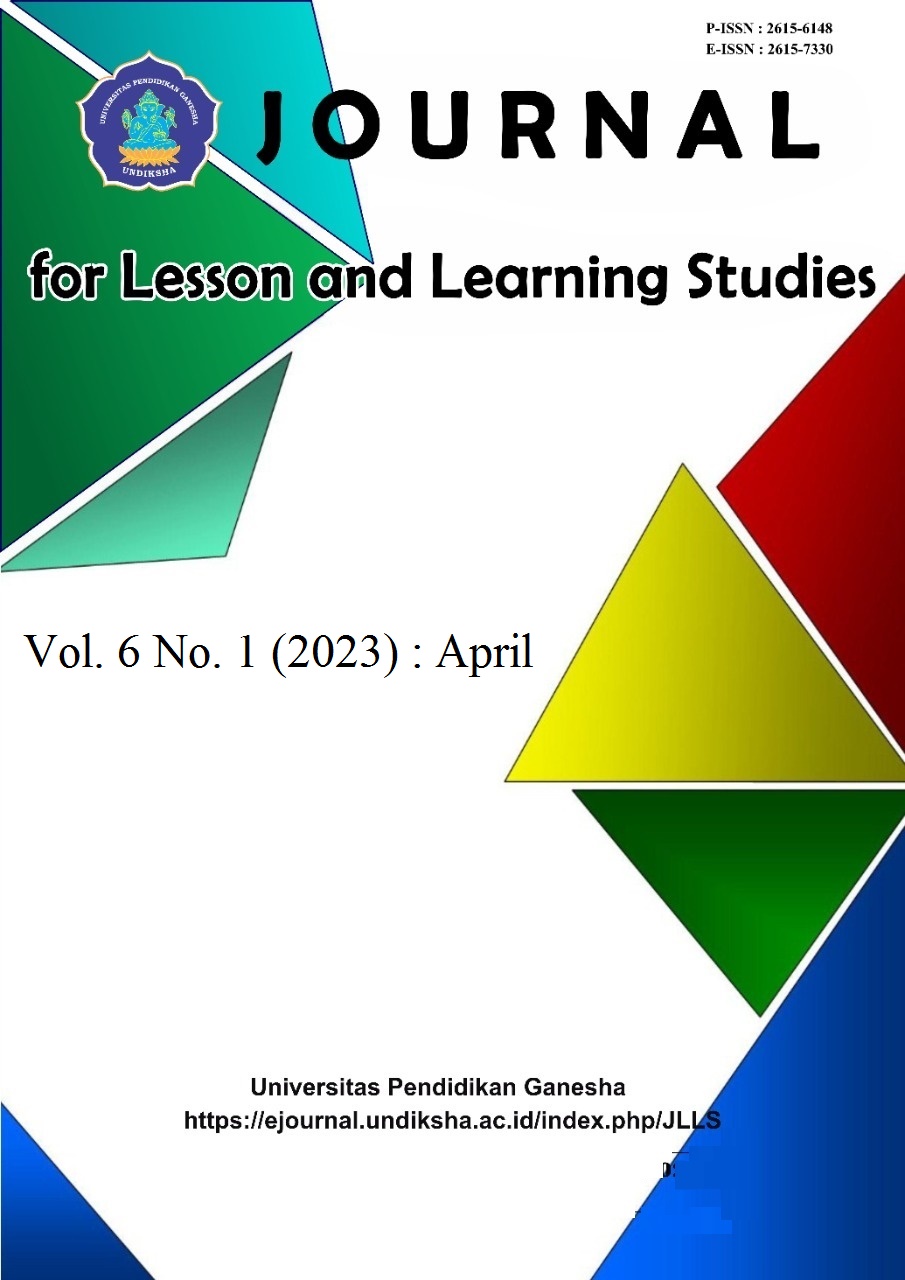Study of Verbal Bullying in Early Adolescents
DOI:
https://doi.org/10.23887/jlls.v6i1.61003Keywords:
Verbal Bullying, Swearing, Insulting, Mocking, VictimAbstract
Verbal bullying is increasingly common among students and sometimes tends to result in serious problems, so it is important to know its forms and causes so that preventive actions can be carried out more quickly by the management of educational institutions. This study aims to find out the forms of verbal bullying and the factors that lead to verbal bullying behavior among the santri of two modern Islamic boarding schools. It uses descriptive qualitative approach, in which the data were taken from santri and teachers at the boarding schools. Words or expressions that contain verbal bullying and factors that cause the behavior of verbal bullying in the schools become the data of this research, which were carried out using observation and interview techniques. The results found that there are 43 verbal bullying expressions, which can be classified by 10 data of dubbing, 9 data of insulting, 9 data of cursing, and 15 data of mocking. The expressions used in verbal bullying are various words or phrases that are often used by children of their age, which are considered normal, because very view expressions that really violate cultural ethics in this area. While factors that cause the verbal bullying were classified into five factors, that were economic ability, seniority tradition, seniority, school disharmony or situation and individual or group characteristics. This shows that the factors that cause verbal bullying in public schools also occur in these pesantren, and the nobel goals that want to achieve by the institutions have not been achieved properly.
References
Almuhajir, A., & Barus, J. (2021). Transformational Leadership of Dayah: Empowerment of Dayah Community In Developing Total Quality Management. Lentera Pendidikan: Jurnal Ilmu Tarbiyah dan Keguruan, 24(1), 91–105. https://doi.org/10.24252/lp.2021v24n1i9. DOI: https://doi.org/10.24252/lp.2021v24n1i9.
Alwi, S., Lubis, S. A., & Lubis, L. (2019). Bullying Behavior in the Integrated Islamic Boarding School at Lhokseumawe City. International Journal on Language, Research and Education Studies, 3(3), 400–411.
Ani, S. D., & Nurhayati, T. (2019). Pengaruh Bullying Verbal Di Lingkungan Sekolah Terhadap Perkembangan Perilaku Siswa. Edueksos : Jurnal Pendidikan Sosial dan Ekonomi, 8(2). https://doi.org/10.24235/edueksos.v8i2.5119. DOI: https://doi.org/10.24235/edueksos.v8i2.5119
Arif, F., & Wahyuni, S. (2017). Hubungan Kelekatan Pada Ibu, Ayah, Dan Teman Sebaya Dengan Kecenderungan Anak Menjadi Pelaku Dan Korban Bullying. Jurnal Psikologi Ulayat, 4(2). https://doi.org/10.24854/jpu22017-100. DOI: https://doi.org/10.24854/jpu58
Aswat, H., Onde, M. K. L. O., & Ayda, B. (2022). Eksistensi Peranan Penguatan Pendidikan Karakter terhadap Bentuk Perilaku Bullying di Lingkungan Sekolah Dasar. Journal of Elementary Education, 6(5). https://doi.org/10.31004/basicedu.v6i5.3389.
Barus, J., Sibarani, R., Saragih, A., & Mulyadi, M. (2018). Linguistic Taboos in Karonese Culture. KnE Social Sciences, 3(4), 411. https://doi.org/10.18502/kss.v3i4.1952. DOI: https://doi.org/10.18502/kss.v3i4.1952
Boske, C., & Osanloo, A. (2016). Students, Teachers, and Leaders Addressing Bullying in Schools. Springer. DOI: https://doi.org/10.1007/978-94-6300-148-9
Capper, T. S., Muurlink, O. T., & Williamson, M. J. (2020). Midwifery students’ perceptions of the modifiable organisational factors that foster bullying behaviours whilst on clinical placement. A qualitative descriptive study. Women and Birth, 1. https://doi.org/10.1016/j.wombi.2020.12.005. DOI: https://doi.org/10.1016/j.wombi.2020.12.005
Chung, J. Y., & Lee, S. (2020). Are Bully-Victims Homogeneous? Latent Class Analysis on School Bullying. Children and Youth Services Review, 112, 104922. https://doi.org/10.1016/j.childyouth.2020.104922. DOI: https://doi.org/10.1016/j.childyouth.2020.104922
Dansie, T. (2019). Basic Counselling Skills for Teachers. Routledge. https://doi.org/10.4324/9780203728895. DOI: https://doi.org/10.4324/9780203728895
Emilda, E. (2022). Bullying di Pesantren: Jenis, Bentuk, Faktor, dan Upaya Pencegahannya. Sustainable Jurnal Kajian Mutu Pendidikan, 5(2), 198–207. https://doi.org/10.32923/kjmp.v5i2.2751. DOI: https://doi.org/10.32923/kjmp.v5i2.2751
Fauzia, Y. R. (2021). Bullying at School : What are the Motives and Causes ? Proceeding of the 1 st International Conference on Social Sciences and Education (ICSSE 2021), Icsse, 13–14.
Goodwin, A. L. (2021). Teaching Standards, Globalisation, and Conceptions of Teacher Professionalism. European Journal of Teacher Education, 44(1), 5–19. https://doi.org/10.1080/02619768.2020.1833855. DOI: https://doi.org/10.1080/02619768.2020.1833855
Hanafiah. (2018). Dayah Collectively as a Social Movement. International Journal of Human Rights in Healthcare, 11(1), 56–64. https://doi.org/10.1108/IJHRH-08-2017-0034. DOI: https://doi.org/10.1108/IJHRH-08-2017-0034
Ihsan, I. (2019). Pesantren-Based Madrasah: Curriculum Implementation Model and Integrative Learning. Media Dialektika Ilmu Islam, 13(2), 401. https://doi.org/10.21043/addin.v13i2.8078. DOI: https://doi.org/10.21043/addin.v13i2.8078
Indra, H. (2017). Salafiyah Curriculum at Islamic Boarding School in the Globalization Era. Tarbiya : Journal of Education in Muslim Society, 4(1). https://doi.org/10.15408/tjems.v4i1.4960. DOI: https://doi.org/10.15408/tjems.v4i1.4960
Juvonen, J., Graham, S., & ... (2014). Bullying in Schools: The Power of Bullies and the Plight of Victims. Annual Review of Psychology, 65(1), 159–185. https://doi.org/10.1146/annurev-psych-010213-115030. DOI: https://doi.org/10.1146/annurev-psych-010213-115030
Khadijah, S. (2018). Bullying And Verbal-Nonverbal Communication Among A Group Of College Students. Jurnal Ilmu Komunikasi, 6(1). https://doi.org/10.36080/avg.v6i1.749. DOI: https://doi.org/10.36080/avg.v6i1.749
Lim, S., & Park, J. H. (2020). The Effect of Beliefs in a just World on Defending Behavior Against Bullying Among Upper Elementary Students and the Moderating Role of Classroom Climate. Korean Journal of Child Studies, 41(2). https://doi.org/10.5723/kjcs.2020.41.2.41. DOI: https://doi.org/10.5723/kjcs.2020.41.2.41
Maghfiroh, N. T., & Sugito, S. (2021). Perilaku Bullying pada Anak di Taman Kanak-kanak. Jurnal Obsesi, 6(3). https://doi.org/10.31004/obsesi.v6i3.1845. DOI: https://doi.org/10.31004/obsesi.v6i3.1845
Mahriza, R., Rahmah, M., & Santi, N. E. (2020). Stop Bullying: Analisis Kesadaran dan Tindakan Preventif Guru pada Anak Pra Sekolah. Jurnal Obsesi : Jurnal Pendidikan Anak Usia Dini, 5(1), 891–899. https://doi.org/10.31004/obsesi.v5i1.739. DOI: https://doi.org/10.31004/obsesi.v5i1.739
Martin, W., & LaVan, H. (2010). Workplace bullying: A review of litigated cases. Employee Responsibilities and Rights Journal, 22(3). https://doi.org/10.1007/s10672-009-9140-4. DOI: https://doi.org/10.1007/s10672-009-9140-4
Mazzone, A., Yanagida, T., Camodeca, M., & Strohmeier, D. (2021). Information processing of social exclusion: Links with bullying, moral disengagement and guilt. Journal of Applied Developmental Psychology, 75. https://doi.org/10.1016/j.appdev.2021.101292. DOI: https://doi.org/10.1016/j.appdev.2021.101292
Menesini, E., & Salmivalli, C. (2017). Bullying in Schools: the State of Knowledge and Effective Interventions. Psychology, Health & Medicine, 22(sup1), 240–253. https://doi.org/10.1080/13548506.2017.1279740. DOI: https://doi.org/10.1080/13548506.2017.1279740
Miles, M.B., & Huberman, A. M. (2014). Qualitative Data Analysis-Third Edition. London: Sage Publication Ltd.
Miles, Mathew B., Huberman, A. M., & Saldana, J. (2014). Qualitative Data Analysis: A Methods Sourcebook (3rd ed). Sage Publications.
Moleong, L. J. (2018). Metodologi Penelitian Kualitatif. Remaja Rosdakarya.
Muhammad, M. (2019). Aspek Perlindungan Anak Dalam Tindak Kekerasan (Bullying) Terhadap Siswa Korban Kekerasan Di Sekolah (Studi Kasus di SMK Kabupaten Banyumas). Journal of Dinamika Hukum, 9(3). https://doi.org/10.20884/1.jdh.2009.9.3.234. DOI: https://doi.org/10.20884/1.jdh.2009.9.3.234
Mukhtar, El-Widdah, M., & Padli, M. (2021). The Impression of Kiai’s Leadership In Managing Islamic Boarding Schools. International Journal of Educational Review, 3(1). https://doi.org/10.33369/ijer.v3i1.11689. DOI: https://doi.org/10.33369/ijer.v3i1.11689
Nashiruddin, A. (2019). Fenomena Bullying di Pondok Pesantren Al-Hikmah Kajen Pati. QUALITY, 7(2), 81. https://doi.org/10.21043/quality.v7i2.6295. DOI: https://doi.org/10.21043/quality.v7i2.6295
Nurlelah, N. (2019). Dampak Bullying Terhadap Kesehatan Mental Santri (Studi Kasus di Pondok Pesantren Darul Muttaqien Parung). Fikrah: Journal of Islamic Education, 3(1). https://doi.org/10.32507/fikrah.v3i1.448.
Oktaviani, P., Syahid, A., & Moormann, P. P. (2020). Santri’s Emotional Intelligence and Big Five Personalities on Bullying Behaviors in Pesantren. Jurnal Pendidikan Islam, 6(2), 179–192. https://doi.org/10.15575/jpi.v6i2.9916. DOI: https://doi.org/10.15575/jpi.v6i2.9916
Prasetyo, M. A. M., & Ilham, M. (2022). Leadership in Learning Organization of Islamic Boarding School After Covid-19 Pandemic. Tafkir: Interdisciplinary Journal of Islamic Education, 3(2), 163–180. https://doi.org/10.31538/tijie.v3i2.175. DOI: https://doi.org/10.31538/tijie.v3i2.175
Purwati, P., Japar, M., Wardani, S., & Rohmayanti, R. (2019). Peningkatan Pengetahuan dan Keterampilan Orang Tua Untuk Mencegah Bullying Guna Mewujudkan Desa Layak Anak. Caradde: Jurnal Pengabdian Kepada Masyarakat, 1(2). https://doi.org/10.31960/caradde.v1i2.67. DOI: https://doi.org/10.31960/caradde.v1i2.67
Putri, L. A. D., Yetti, E., & Hartati, S. (2020). Pengaruh Keterlibatan Orangtua dan Regulasi Diri terhadap Perilaku Bullying Anak Usia Dini. Jurnal Obsesi : Jurnal Pendidikan Anak Usia Dini, 4(2). https://doi.org/10.31004/obsesi.v4i2.438. DOI: https://doi.org/10.31004/obsesi.v4i2.418
Quintana-Orts, C., Rey, L., & Worthington, E. L. (2021). The Relationship Between Forgiveness, Bullying, and Cyberbullying in Adolescence: A Systematic Review. Trauma, Violence, & Abuse, 22(3), 588–604. https://doi.org/10.1177/1524838019869098. DOI: https://doi.org/10.1177/1524838019869098
Rahmatullah, A. S., Suud, F., & Azis, N. (2022). Healing Bullying Behavior on Santri at Islamic Boarding School. Cendekia: Jurnal Kependidikan dan Kemasyarakatan, 20(2), 240–258. https://doi.org/10.21154/cendekia.v20i2.4872. DOI: https://doi.org/10.21154/cendekia.v20i2.4872
Raya, M. K. F. (2021). Dayah and Meunasah in Aceh: Reform in Local Context. Jurnal Tatsqif, 19(1), 21–40. https://doi.org/10.20414/jtq.v19i1.3504. DOI: https://doi.org/10.20414/jtq.v19i1.3504
Rosen, L. H., DeOrnellas, K., & Scott, S. R. (Reds). (2017). Bullying in School. Palgrave Macmillan US. https://doi.org/10.1057/978-1-137-59298-9. DOI: https://doi.org/10.1057/978-1-137-59298-9
Rosen, L. H., Scott, S. R., & DeOrnellas, K. (2017). An Overview of School Bullying. In Bullying in School (bll 1–22). Palgrave Macmillan US. https://doi.org/10.1057/978-1-137-59298-9_1. DOI: https://doi.org/10.1057/978-1-137-59298-9_1
Ru’iya, S. (2019). A Review of Research on Bullying Behavior in Indonesian Islamic Education Institutions: Analysis of Ecological Theory. In 2019 Ahmad Dahlan International Conference Series on Education & Learning. Social Science & Humanities. https://doi.org/10.2991/adics-elssh-19.2019.14. DOI: https://doi.org/10.2991/adics-elssh-19.2019.14
Salabi, A. S., & Prasetyo, M. A. M. (2022). The Internalization of Banjaran Cultural Character Values in Mustafawiyah Islamic Boarding School, Purbabaru. MIQOT: Jurnal Ilmu-ilmu Keislaman, 46(2). https://doi.org/10.30821/miqot.v46i2.900. DOI: https://doi.org/10.30821/miqot.v46i2.900
Siyoto, S., & Sodik, M. A. (2015). Dasar Metodologi Penelitian (1st ed). Literasi Media Publishing.
Sung, Y.-H., Chen, L.-M., Yen, C.-F., & Valcke, M. (2018). Double Trouble: The Developmental Process of School Bully-Victims. Children and Youth Services Review, 91, 279–288. https://doi.org/10.1016/j.childyouth.2018.06.025. DOI: https://doi.org/10.1016/j.childyouth.2018.06.025
Thornberg, R., Wänström, L., & Jungert, T. (2018). Authoritative classroom climate and its relations to bullying victimization and bystander behaviors. School Psychology International, 39(6). https://doi.org/10.1177/0143034318809762. DOI: https://doi.org/10.1177/0143034318809762
UNESCO. (2019). Behind the Numbers: Ending School Violence and Bullying. In Sustainable Development Goals: Education 2030.
Waliyanti, E., & Swesty, F. A. (2021). Phenomena of Bullying Behaviour on Adolescents in Boarding School. JKKI: Jurnal Kedokteran dan Kesehatan Indonesia, 124–136. DOI: https://doi.org/10.20885/JKKI.Vol12.Iss2.art5
Widaningtyas, L., & Sugito, S. (2022). Perspektif Orang Tua dan Guru Mengenai Bullying Pada Anak Usia Dini di Taman Kanak-kanak. Jurnal Obsesi, 6(4). https://doi.org/10.31004/obsesi.v6i4.2313. DOI: https://doi.org/10.31004/obsesi.v6i4.2313
Wolf, S., & Suntheimer, N. M. (2020). Predictors of Parental Disciplinary Practices and Associations with Child Outcomes among Ghanaian Preschoolers. Children and Youth Services Review, 112, 104518. https://doi.org/10.1016/j.childyouth.2019.104518. DOI: https://doi.org/10.1016/j.childyouth.2019.104518
Zainal, S., Prasetyo, M. A. M., Yaacob, C. M. A., & ... (2022). Adopting Pesantren-Based Junior High School Programs: The Pesantren Change Its Educational System Without Conflict. Jurnal Ilmiah Islam Futura, 22(2). https://doi.org/10.22373/jiif.v22i2.13525. DOI: https://doi.org/10.22373/jiif.v22i2.13525
Zakiyah, E. Z., Humaedi, S., & Budiarti, M. (2017). Faktor Yang Mempengaruhi Remaja dalam Melakukan Bullying. Prosiding Penelitian dan Pengabdian kepada Masyarakat, 4(2). https://doi.org/10.24198/jppm.v4i2.14352. DOI: https://doi.org/10.24198/jppm.v4i2.14352
Downloads
Published
How to Cite
Issue
Section
License
Copyright (c) 2023 Jumat Barus, Ninda Safitri, Husaini

This work is licensed under a Creative Commons Attribution-ShareAlike 4.0 International License.
Authors who publish with the Journal for Lesson and Learning Studies agree to the following terms:
- Authors retain copyright and grant the journal the right of first publication with the work simultaneously licensed under a Creative Commons Attribution License (CC BY-SA 4.0) that allows others to share the work with an acknowledgment of the work's authorship and initial publication in this journal.
- Authors are able to enter into separate, additional contractual arrangements for the non-exclusive distribution of the journal's published version of the work (e.g., post it to an institutional repository or publish it in a book), with an acknowledgment of its initial publication in this journal.
- Authors are permitted and encouraged to post their work online (e.g., in institutional repositories or on their website) prior to and during the submission process, as it can lead to productive exchanges, as well as earlier and greater citation of published work. (See The Effect of Open Access)




